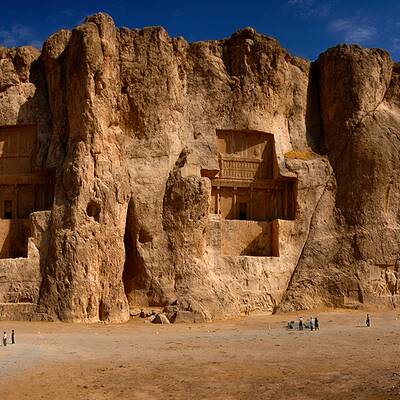
Naqsh-e Rostam
MarvdashtNaqsh-e Rostam is a great treasure placed in the heart of the mountains in the historic region of Marvdasht. It is a region with the glorious and eye-catching mountains showing an ancient grandeur. Embraced several monuments belonging to Elamite, Achaemenid and Sassanid eras, Naqsh-e Rostam owes indeed its reputation to four Achaemenid kings who have been buried here. It is said that due to the similarity between Sassanid motives to Rostam, the famous Shahnameh hero, this region has been called Naqsh-e Rostam, while there are no traces of Rostam here.
The area presents a perfect depiction of monuments from different periods; the most ancient work here is an Elamite relief depicting two goddesses, king and queen sitting on a curled snake- like thrown. However, some parts of this memorial have been eliminated by the order of Bahram II to be replaced by the figure of the king and his courtiers.
Another significant monument in this mysterious land, which is standing in the heart of the vast plain of Fars, just like a glorious and authentic jewel, is the Ka'ba-ye Zartosht, or the Cube of Zoroaster; It is a cube building with a staircase right in the front, made of limestone and it is nearly twelve meters high. The main function of this building has not yet been clear; some believe that it had probably been a fireplace and some kind of temple. Others state that it is a tomb and some experts consider it to be the place of protecting the holy book and documents.
A tomb for Darius the Great
One of the most principal monuments in Naqsh-e Rostam is the tomb of Darius the great, a notable king for Iranians. He fought with the untruth and deception, through killing the false Bardiya, to spread the justice in the land. Darius had ordered to be buried inside a crypt in the heart of the silence of the mountain, and after him, other kings like Xerxes I (the older son of Darius), Darius II and Artaxerxes I and some other relatives were also buried in the heart of the similar crypts. Some believe that these crypts were the invention of Darius and the other crypts imitated his invent. Some others say that kings’ bodies have been buried here to not pollute the earth.
These four crypts are similar and some little differences in size or details or the inscriptions have led experts to consider each to be belonged to a different Achaemenid king. There are also other tombs inside the crypt. For example, there are nine other tombs inside the Darius crypt which are probably related to his relatives.
Shapur I's victory relief over the Rom emperor is one of the other famous monuments in this area; here Shapur I, the Sassanid king, is standing on the horse on the body of this emperor. The other one is a relief depicting Ardashir I receiving the royal ring from Ahura Mazda which remind us of the historic importance of Naqsh-e Rostam.
